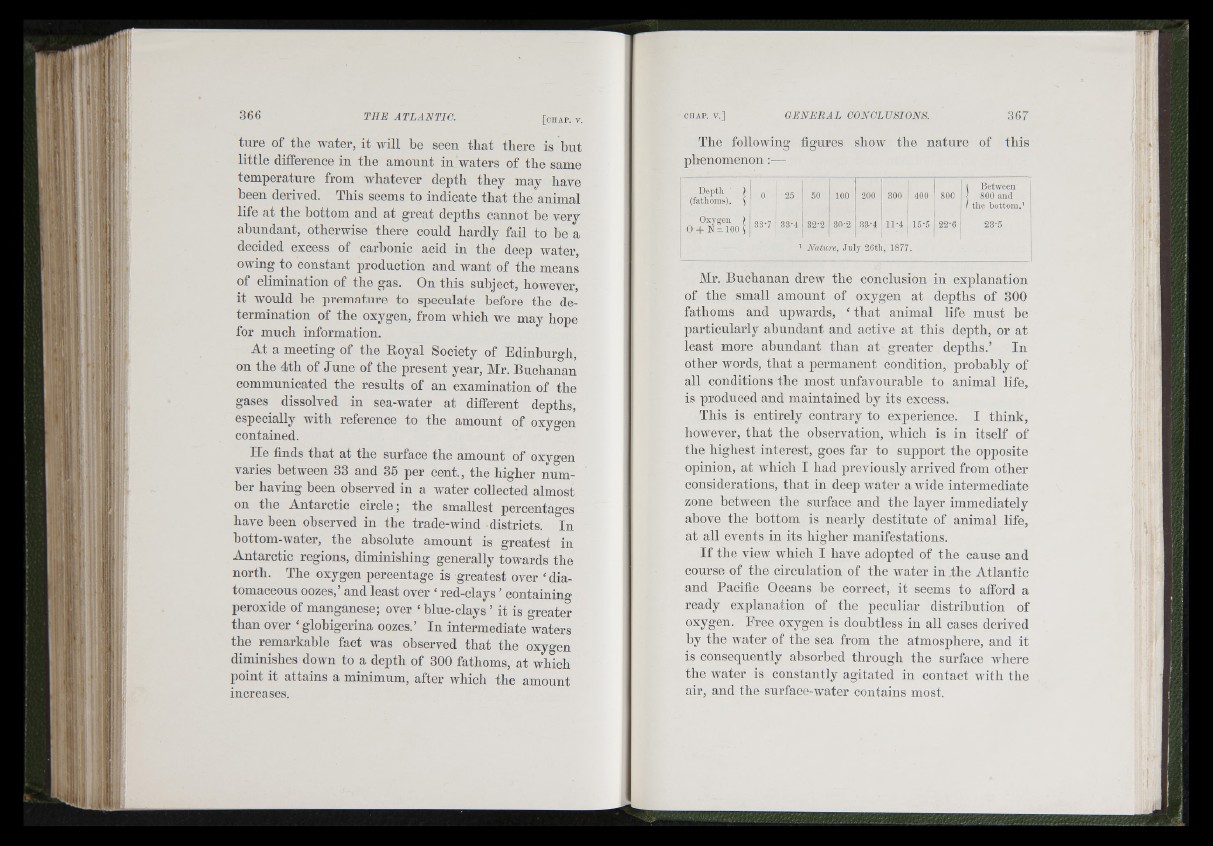
I 'lii
m
%
ture of the water, it will be seen tbat tbere is but
little difference in tbe amount in waters of tbe same
temperature from whatever deptb they may have
been derived. This seems to indicate that tbe animal
life at tbe bottom and at great depths cannot be very
abundant, otherwise there could hardly fail to he a
decided excess of carbonic acid in the deep water,
owing to constant production and want of the means
of elimination of the gas. On this subject, however,
it would he premature to speculate before the determination
of the oxygen, from which we may hope
for much information.
At a meeting of the Royal Society of Edinburgh,
on the 4th of June of the present year, Mr. Buchanan
communicated the results of an examination of the
gases dissolved in sea-water at different depths,
especially with reference to the amount of oxygen
contained.
He finds that at the surface the amount of oxygen
varies between 33 and 35 per cent, the higher number
having heen observed in a water collected almost
on the Antarctic circle; the smallest percentages
have been observed in the trade-wind districts. In
bottom-Avater, the absolute amount is greatest in
Antarctic regions, diminishing generally towards the
north. The oxygen percentage is greatest over ‘ dia-
tomaceous oozes,’ and least over ‘ red-clays ’ containing
peroxide of manganese; over ‘blue-clays ’ it is greater
than over ‘ glohigerina oozes.’ In intermediate waters
the remarkahle fact Avas observed tbat tbe oxygen
diminisbes doAvn to a deptb of 300 fathoms, at which
point it attains a minimum, after which the amount
increases.
CHAP. V.]
The
phenomenon :
following figures show the nature of this
Deptii I
(fathoms). ( 0 ■ 25 50 100 200 300 400 800
i Between j 800 and
/ the bottom.'
Oxygen \
0 + N^lOO S 33-7 ; 33-4 32-2 30-2 33-4 11-4 15-5 22-6 23-5
1 Nature, July 26th, 1877.
Mr. Buchanan dreAV the conclusion in explanation
of the small amount of oxygen at depths of 300
fathoms and upwards, ‘ that animal life must be
particularly ahundant and active at this depth, or at
least more abundant than at greater depths.’ In
other words, that a permanent condition, probably of
all conditions the most unfavourable to animal life,
is produced and maintained hy its excess.
This is entirely contrary to experience. I think,
however, that the observation, which is in itself of
the highest interest, goes far to support the opposite
opinion, at which I had previously arrived from other
considerations, tbat in deep water aAvide intermediate
zone betAveen tbe surface and tbe layer immediately
above tbe bottom is nearly destitute of animal life,
at all eveuts in its bigber manifestations.
If tbe view wbicb I bave adopted of tbe canse and
course of tbe circulation of tbe Avater in tbe Atlantic
and Pacific Oceans be correct, it seems to afford a
ready explanation of tbe peculiar distribution of
oxygen. Pree oxygen is doubtless in all cases derived
by tbe water of the sea from the atmosphere, and it
is consequently absorbed tlirougli tbe surface Avhere
tbe Avater is constantly agitated in contact Avitb tbe
air, and tbe surface-water contains most.